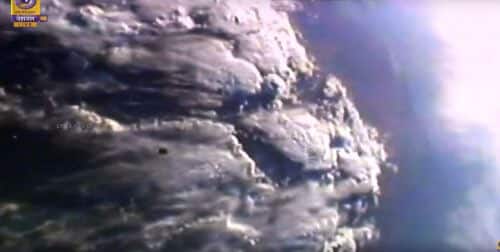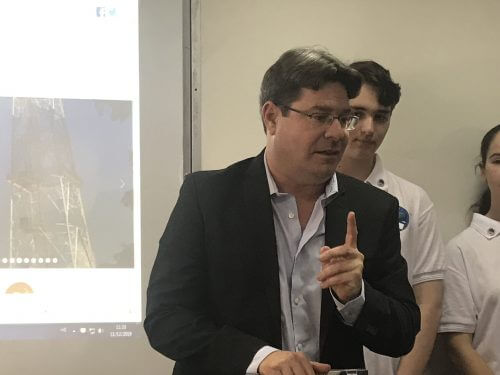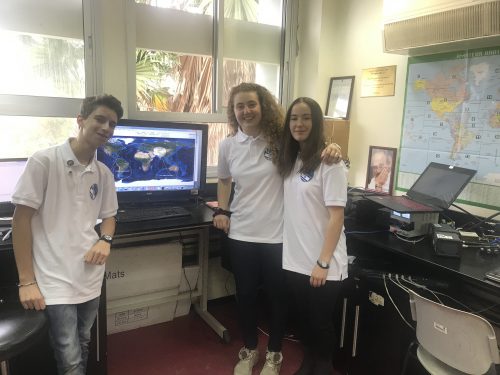The successful launch from India and the smooth ejection of the satellite from the launcher, as well as the reception of transmissions from the satellite, although not directly, resulted in a high tension of work that lasted for three years, by high school students from Herzliya and the Negev Gate who built it

After two years of work, today, five minutes before 12:00 Israel time, it happened - the satellite "Dokifat 3", which was designed and built entirely by students from Shaar Hanegev High School and the Herzliya Science Center, was launched into space to an altitude of 550 km from the launch station in Chennai, India .
About an hour and a half after launch, the satellite was supposed to give the first signals to the ground station in Herzliya, but the signals were not received. However, radio amateurs from all over the world picked up the signals when the satellite passed over their stations, and they relayed them to the control center, where they deciphered them and learned from them that all satellite systems are working as ordered and as planned. Tomorrow at six in the morning another passage of the satellite is expected over Israel, this time higher above the horizon compared to the current passage.
The satellite, whose cost is estimated at NIS 3 million, is a joint project of the Israel Space Agency, the Ministry of Science and Technology, the Herzliya Science Center, the Shaar HaNegev Regional Council, the Municipality of Herzliya and the YKA Foundation.
Dokifat 3 is the third satellite built entirely by students in Israel. Dokifat 3, like its predecessors, Dokifat 1 and Dokifat 2, serve as an applied and fascinating educational platform for students that encourages more students to join the studies of STEM subjects in general (science, technology, engineering and mathematics) and space studies in particular. The project is accompanied by a team of mentors consisting of experienced engineers from the space industry and academia who all lend a hand and take part in the project, they guide the students and help them gain knowledge and experience.


Minister of Science and Technology Ofir Akunis: "The whole world looks at us, the State of Israel, at you, the students and at your mentors, at all those who laid the foundation for Israel to be a science, technology and innovation powerhouse. We work to promote the accessibility of science everywhere, in every religion and in every sector. All citizens of Israel should be a part of this miracle and for that I have worked for the last four years as Israel's Minister of Science and Technology."
Dokifat 3 is a remote sensing satellite whose purpose is to photograph the Earth and to be a platform for carrying out research in the fields of ecology and earth sciences. The satellite, which measures 10x10x30 cm and weighs about 3.3 kg. The satellite is equipped with a camera and on-board algorithms for image processing, and it will be able to monitor soil and water contamination, air pollution, track rainforests, urban development, ecological disasters and more. The satellite will be launched into a relatively low orbit (LEO) at an altitude of 550 km, which will allow experiments to be carried out in a controlled manner. It has the ability to load software from the ground and it will be possible to send commands through supervision from the ground.
About 60 male and female students from grades 3 to 50 participated in the last two years in the construction of Dokifat 10 (8 from schools in Herzliya and another XNUMX from Shaar Hanegev High School). The students worked in teams on planning and developing the satellite, writing the software that operates it and testing it with the help of mentors who come from industry or academia. In addition, the students prepared the ground station at the Science Center for full communication with the satellite after launch, when it should circle the Earth every hour and a half at a speed of about XNUMX kilometers per second.
After the success of the launch was announced, we spoke with two of the graduates - Gefen Avraham and Hilla Rivlov, and with the CEO of the project on behalf of the students, Gal Levin.
According to Gefen Avraham, SATNOGS - a worldwide network of radio amateurs who follow satellites and try to receive them. They managed to receive the satellite for the first time in Panama, a little later they received it in Puerto Rico.
According to him, in the framework of the Dokifat 3 project as part of his high school studies, he developed the mission planning software, and as a graduate he came to watch the launch and assist in receiving the first signals. "Now working on the development of cheaper satellites, not only entities like us that are well funded by the Herzliya municipality and the government, but every school in the world will be able to build and launch satellites and develop the scientific and technological knowledge of the students. I do this in an independent framework funded by the Foundation for the Advancement of Young Entrepreneurs in the USA, and George Mason University in Washington, DC.
Gal Levin, CEO of the project, says that today was very exciting. "The launch was successful, the transition was not optimal, the conditions were not good, so we will return tomorrow at six in the morning to receive it, but other places around the world received the satellite and we know that it is functioning.
"A very, very exciting day, it's really the end of three intense years of work where we worked day and night on this satellite and now to see that it's really functioning and transmitting is an amazing achievement and now we're entering the operational period where we send commands every day, receive telemetry. Our first task will be to stabilize the satellite and after that we will start taking pictures."
What is it like to be part of a unique project in the world
Levin: "I feel that I have a great privilege to participate in such a unique project, not many people have the opportunity. I'm glad I discovered the project and joined. It's much more interesting than anything else I've done technologically as well. I learned a lot - here I also studied satellite communication, general radio communication, software, physics related to direction control. Plus it gave me a lot of confidence to speak in front of an audience. Many skills I will use later in life.
Hila Rivlov, as mentioned a graduate of the project: "The project has so much contribution that we only manage to understand part of it. We receive knowledge that is also scientific and technological information but we also learn about teamwork and cooperation and I'm sure there are many other areas we are exposed to and don't even know we received. When we get older and go to work, we will come across things and say, oh, it was in the Dokifat 3 project. This project is unusual in the world, it only exists here, only in the Herzliya Science Center, only in Israel. There is no other place where students can build a satellite, launch it into space and communicate with it regularly."
"Today was one of the most exciting and amazing and stressful days I've been a part of. And I am happy that the satellite is functioning as it is and that they managed to receive it, but we still have a lot of work to do. We need to receive it at our station and start working - take pictures and carry out the scientific mission of the satellite."
Rivlov is also happy about the cooperation with the Shaar Negev students. "We got to meet friends who are not from our environment and work with them in a very professional and challenging environment.
More of the topic in Hayadan:
- "Dokifat 3 proves that even under the threat of rockets and rockets it is possible to have quality scientific education" update on the success of the launch
- The Dokifat 3 satellite will be launched in about two weeks from India
- Dokifat 3 which is currently under development; Will be part of a cast of Israeli student satellites of the Israel Space Agency
- Dokifat satellites brought the Science Center and Herzliya Municipality the Marco Polo Society Award

One response
Wow amazing, well done!
Some data is missing on the capabilities of the satellite. Does it take pictures in the visible light range, or at other frequencies?
It says that he will be able to do so and so, are there already projects ready for the satellite, or is it a platform that is waiting for projects in the fields mentioned?
Is it possible to take pictures from the satellite at any time, or does it involve additional costs?